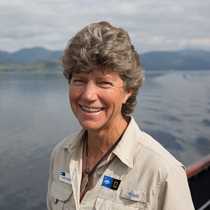This morning we ventured out into Loch Ness after making our way down the Fort Augustus locks. As we sailed across the Loch, David presented the history of the Highland Clearances, describing the situation that led to the battle of Culloden and the end of the Jacobite uprising. What followed the Jacobite defeat at Culloden was repression of the Highland culture, and the creation of large estates across the Highlands. In the 19th century, the Highland tenants on the estates were forcibly cleared from the inland to create sheep farms, and moved to coastal crofts and planned communities (such as Plockton) or sent overseas. David’s talk gave us the background to appreciate the Culloden Battlefield on our afternoon visit.
Stewart followed David with a background on the Loch Ness Monster, giving us ideas on what to look for in our search for Nessie. The Monster (who, of course, does exist!) may be a plesiosaur, may be something else. Who knows? Robin ended the series of morning presentations with a talk called “The Rise and Fall of the Caledonian Forest” where she talked about the environmental history of Scotland and explained how climate change and human impact has resulted in a huge decline in forest cover in Scotland. 6000 years ago, forest covered 60% of Scotland. By 1900, that had declined to less than 6%.
As we crossed Loch Ness, the ship paused near Urquhart Castle. This medieval castle has a violent history - it was seized by King Edward I then regained by Robert the Bruce, King of Scots in the 14th century. The MacDonald’s, Lords of the Isles, attacked the castle frequently in the 15th and 16th century. The castle is now a ruin, blown up in 1692 so that Jacobite rebels couldn’t make use of it, leaving only picturesque crumbled towers and walls. It is a prime Nessie-spotting place, but we saw no sign of the great monster today.
From Loch Ness, we enjoyed our last hours of sailing, eventually descending a flight of four locks to arrive in Muirtown Basin, our final stop for the day. After lunch, we disembarked and took a bus to Culloden Battlefield. Culloden is the site of the 1746 battle that ended the campaign of Prince Charles to regain the throne for the Stuart Dynasty. Prince Charles’ troops were brutally defeated at Culloden, with the resulting suppression of Highland culture and 19th century clearances. The Culloden Visitor Centre is an award-winning museum, providing a detailed history of the battle and events leading up to the final conflict. The Battlefield is a graveyard where many of those killed in the fight were buried. It is now a remnant of the boggy moorland the soldiers had to deal with during the battle, having been drained and planted in past decades.
After Culloden, we went back into prehistoric times, with a visit to Clava Cairns, a site of Bronze Age burial cairns and standing stones, constructed around 2000 to 1500 B.C. Three massive cairns dominate the site, two of them with passages aligned to catch the sun’s rays on the winter solstice.
The day ended with a gala celebration: the captain’s Farewell Reception and the slide show of photos from our week of travel. Dinner included guest manager Brian’s recitation of Robert Burn’s “Ode to the Haggis,” with a chance to taste this “chieftain of the pudding race.” Our final event of the week was a visit by young Scottish dancers, who performed traditional dancing to the tunes of the Scottish bagpipe. So ended our week in the Highlands and Islands of Scotland. As they say in this beautiful country, “Haste Ye Back!”









